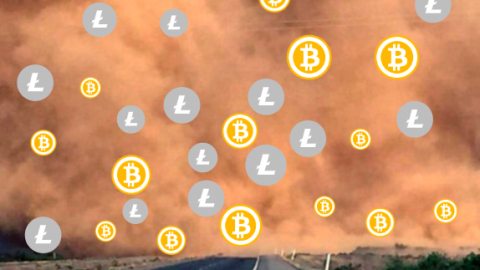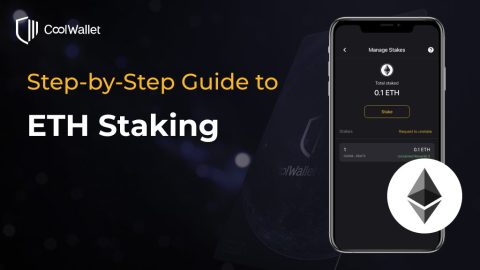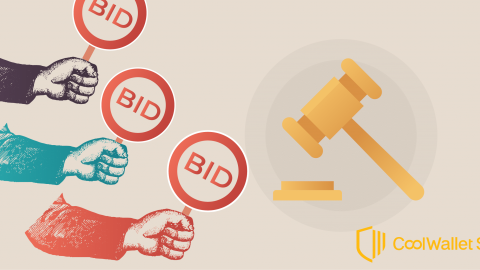Table of Contents
- Introduction
- What is DeFi?
- How did DeFi become so popular?
- Defi Hacks, Scams and Rugpulls
- Why Should I Use DeFi Platforms?
- DeFi use cases
-borrowing and lending
–yield farming
-staking
-decentralized exchanges (DEX)
–DAO governance
-non-fungible tokens (NFT) - How do DeFi protocols work?
- Challenges for DeFi
- The most popular DeFi projects
- How to get started with DeFi
- Are DeFi tokens a good investment?
- Things to consider before entering DeFi
- Conclusion
1. Introduction
In mid-2020 a new crypto sector called Decentralized Finance exploded in value and growth. DeFi, as it’s called, uses smart contract technology to offer traditional finance services in crypto, and has led a surge of disruptive new Dapps, decentralized exchanges (DEX), lending and staking platforms and yield farming protocols making early investors very rich and leading to a gold rush of new buyers. DeFi continued to grow in 2021, but ceded the spotlight to new entrants like NFTs, SocialFi and Web3, all which incorporate elements in their most popular protocols. As crypto prices came down to earth in 2022, so did the DeFi market, with investors hesitant to invest too much due to the big risk of rug pulls, impermanent loss, and smart contract vulnerabilities they’ve experienced since 2021.
In our DeFi guide, we’ll cover the most important things to know for DeFi newcomers and risk-taking “degens” alike.
2. What is Decentralized Finance (DeFi)?
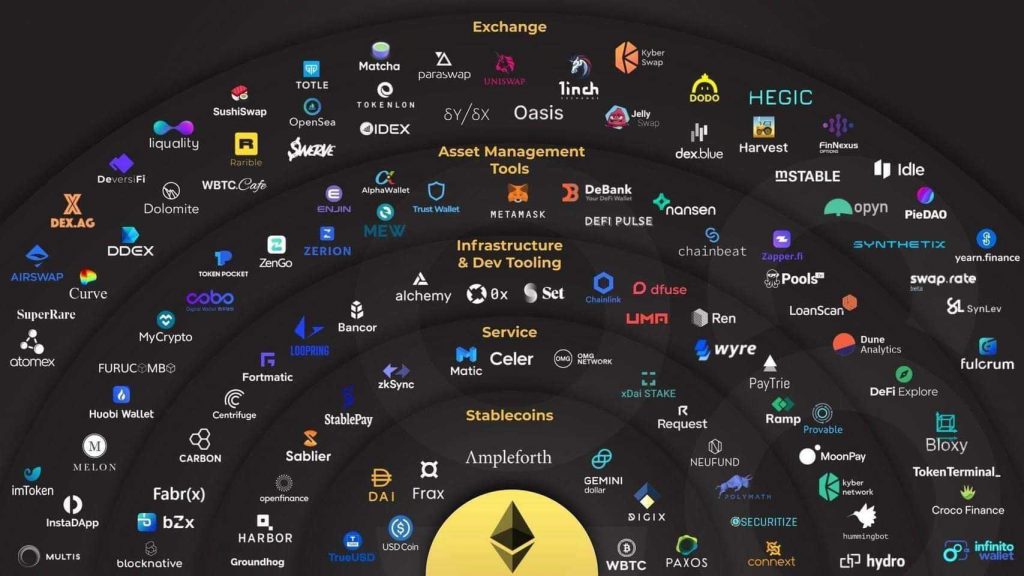
This essential DeFi guide covers the wild rise of decentralized finance, its most popular projects and security advice.
Decentralized finance (DeFi) refers to a sector of the cryptocurrency industry that deals with financial applications that are independent of central financial intermediaries like banks, centralized exchanges, etc., and instead, replaces them with smart contracts, which run on blockchains or distributed ledger technologies (DLTs).
DeFi or Open Finance (OpFi) also refers to the decentralized applications (Sapps) themselves, such as loans, asset trading, savings, insurance, lending, etc. that are more inclusive, allowing anyone in the world access as long as they have a smartphone and internet.
Additionally, the smart contracts used to create DeFi employ open-source code, opening them to community auditing. And by eliminating intermediaries, DeFi users are able to maintain full control over their virtual wealth, as well as directly interact with them via a dapp.
3. How did DeFi become popular?
Decentralized lending was popularized by the Maker platform, one of the earliest DeFi projects to successfully launch. Crypto holders are able to lend and borrow Maker’s stablecoin, DAI, in a decentralized way.
After the success of Maker, several other decentralized lending platforms followed suit, enjoying various degrees of success, while the market remained very small.
On January 1st, 2020, the total value locked (TVL) in USD was “only”$690 million”. On 1 January 2022, it was over $170 billion! While the market has since retraced to a current TVL of $53 billion (September 2022), it’s still a staggering number of growth.
The DeFi run took off in full flight in June 2020 when Compound Finance released its governance token COMP, which soon attracted record returns for holders. This ushered a new era of yield farming (liquidity mining), where liquidity providers are rewarded with high returns as well as a DeFi native token that can be used for staking and governance.
Soon enough other projects followed. Due to the insane returns offered by these new protocols, and their often small coin supplies, investors flocked in. For old hands it felt like the ICO Summer of 2017 was happening all over again.
With a new paradigm of decentralized lending, trading, staking, borrowing and complex derivatives such as Ethereum-powered stablecoin protocol Ampleforth (the whitepaper is a must-read), a whole new world of finance opened up, independent of the constraints, sluggishness and regulations of traditional finance.
And when yield farming exploded in popularity, it gained another utility.
Stablecoins were a favorite among yield farmers who wanted to earn high-interest rates thanks to their stability and profitability. Exchange stablecoins, in particular, became widely popular, which led to the rise of another popular DeFi platform, Curve, whose TVL is composed mostly of stablecoins.
With centralized exchanges subject to more regulations and hacks and scams, more and more investors turned to decentralized exchanges (DEX) where they could trade the latest and hottest DeFi smart contract tokens for ETH or USDT (ERC20).
Uniswap is probably the biggest DEX success story last year and helped to catalyze the DeFi boom in 2020 by allowing any individual to create and list smart contract-based ERC20 tokens freely on the Ethereum chain without any hurdles.
This extremely user-friendly exchange popularized liquidity mining, which is the act of depositing assets as collateral in order to earn rewards. When new competitor SushiSwap took its shine by issuing its own SUSHI governance coin, UniSwap had one trick up its sleeve, airdropping 400 of its own new UNI governance token to every user who had used its exchange. Peaking at a value of $8 a coin in the trading frenzy aftermath, this later became known as the “DeFi stimulus check” and kickstarted the industry back into action.
And then there’s Yearn Finance, who finally completed the “flippening” and briefly stole Bitcoin’s crown as the most expensive cryptocurrency, going from $300 to $42,000!
Yearn and its governance token, YFI, rose to provide the ultimate DeFi aggregation service that enabled the average user to optimize their profits among the multitude of DeFi protocols. It used the best of smart contracts and traditional finance and made a star and DeFi guru of its founder, South African developer Andre Cronje.
DeFi’s rapid market growth resembled the ICO bubble in 2017 when things got a little ridiculous, to say the least. Unfortunately, the mayhem had just begun.
When Yam Finance became popular, it set the stage for a new batch of protocols named after foods, also known as “food coins”.
The vast majority of food projects were scams, failing to offer anything of value beyond yield farming. Some of these protocols include Kimchi, Hotdog, Ketchup, and other frivolous-sounding projects.
When Yam raised over $500m in locked value in days, only to have a smart contract vulnerability jeopardize all the funds, it took the brakes off the first DeFi boom. The hacking of DeFi darling Cronje’s production testing-only Eminence smart contract for millions drove home the importance of due diligence and auditing of smart contracts before they’re released.
4. DeFi Hacks, Scams and Rugpulls

DeFi is not all rainbows and unicorns. In fact, there have been various incidents that prove just how risky dabbling in it can be. The unfortunate fact is that if you invest in DeFi projects, you stand the chance to lose everything.
In addition to the Yam and Eminence incidents perhaps one of the unluckiest DeFi protocols has to be bZx, which was hacked three times in 2020 alone. First was on February 14 when it suffered an exploit that allowed a hacker to steal $350,00 worth of assets in a flash loan attack. Four days later, the platform suffered the same type of attack, losing $650,000 this time.
What is a flash loan attack?
A flash loan attack is a type of cyber attack where the hacker makes a loan from a DeFi platform and utilizes the borrowed funds to manipulate prices to his advantage, allowing him to drain a project’s pool. Most DeFi hackers have used this M.O.
bZx was hacked for the third time on Sep 13, only this time, the hacker had exploited a vulnerability in its protocol, which allowed him to mint unbacked tokens and then trade them for cryptocurrencies like ETH, DAI, etc.
Perhaps the biggest DeFi hack in 2020 though was with Lendf.me when an attacker was able to steal $25 million after exploiting a vulnerability in its ERC-777 token standard.
What is a rugpull?
A record number of new and fly-by-night DeFi protocols entered and swiftly exited decentralized marketplaces like UniSwap and SushiSwap after suffering so-called “rug pulls”. A DeFi rug pull is when a hacker or unscrupulous developer, usually anonymous, drains the liquidity pool and steals all the funds. This happened over and over in 2020, where many scam projects hastily copied code from other legitimate projects and duped investors with insanely high annual percentage Yield (APY) and liquidity incentives.
Notably, the differences between DeFi and conventional financial institutions are almost limitless. To add to the above points, DeFi protocols have a flexible user experience and are interoperable. For example, it’s easy to combine the functionalities of many DeFi protocols under a single product.
5. Why Should I Use DeFi platforms?
The advantages of decentralized finance revolve around their profound stab on Wall Street. Here are some of the reasons why you should use DeFi platforms:
They are decentralized
The distributed nature of DeFi platforms and protocols makes them available across the world and allows the development of modular applications enabling a single network to have various features. Additionally, the absence or lack of central control makes it hard if not impossible for financial watchdogs to shut down DeFi services.
Furthermore, being decentralized translates to being non-custodial, which means that users have full control of their funds, unlike depositing money in a bank account.
No intermediaries means no excessive costs
In DeFi, it’s all about peer-to-peer transactions since dApps power the ecosystem using self-executing code that envisages the outcome and resolution of activities on these platforms. This prevents rent-seeking behavior since no one can make profits without providing value.
Fast easy access
The protocols are easily accessible, making it possible for the unbanked to experience banking-like services. Most of the unbanked individuals are from low-income backgrounds. Since traditional banking services rely on intermediaries who charge exorbitant fees, DeFi applications not only make financial services accessible but also affordable.
Records are immutable
Blockchain technology powers DeFi protocols. On the blockchain, committed transactions can only be viewed but not altered. A blockchain like Ethereum lives on thousands of computers worldwide, eliminating a single source of failure. This avoids traditional finance problems like fraud and corruption, as everything is recorded and can be traced back to you.
App development is NOT dictated by deployment
Frameworks supporting DeFi protocols can be developed long before deployment. As such, the deployment process becomes easy and secure since the team has the time to hunt for any bugs or shortcomings.
6. DeFi’s Best Use Cases
Note that thanks to the capabilities of smart contracts, the applications of DeFi virtually have no limits. If you can dream it, you can code it. In fact, the FTX exchange is now even offering a tokenized version of the wildly popular GameSpot share (GME) that can be traded on its platform! Below follows some of the most popular use cases in 2021.
Peer-to-Peer Borrowing and Lending
Decentralized lending platforms are Dapps that allow users to either lend or borrow digital currencies.
To unearth the power of this use case, open networks programmatically determine critical aspects such as interest rates. The interest rate is two-pronged. There’s the rate that borrowers pay, and the one that lenders receive for providing liquidity.
This use case allows “outcasts” from conventional banking firms to access loans from anonymous persons across the world. Some DeFi protocols offer crypto loans against fiat collateral and vice versa.
Apart from loans, DeFi users can borrow a token to participate in blockchain activities such as governance.
Yield farming (Liquidity Mining)
Yield farming, also called liquidity mining, is the act of hunting for rewards by interacting with DeFi protocols. While it sounds simple and straightforward, the actual job is more demanding.
Yield farmers need to implement complex yield farming strategies. Some of these strategies may dictate that they continually move their cryptocurrencies across multiple platforms to hunt for higher returns, such as Yearn Finance. Furthermore, the farmers need to be tight-lipped about the best approach to continue having an edge over other farmers.
While liquidity mining has some similarities with staking on PoS blockchains, there are vital differences between them. For example, liquidity miners/yield farmers add funds to liquidity pools while stakers either hold funds in a wallet or delegate their coins to a validator node.
A liquidity pool is simply a smart contract that holds deposited cryptocurrency meant to power different spheres of a DeFi platform. Different pools offer different rewards to LPs (liquidity providers). Therefore, yield farmers tend to move their funds around looking for a pool with the highest incentives.
In some cases, they may even deposit in different pools with different rewards. Liquidity mining has higher rewards compared to staking. However, the higher the returns, the higher the risks and vice versa.
Proof of Stake (PoS) networks and crypto staking
Staking involves locking assets in a wallet in order to gain governance rights and token rewards in proof of stake (PoS) blockchain’s native asset. For instance, if a user stakes his ETH in Ethereum 2.0’s beacon chain, he’ll be rewarded with ETH as well.
Block rewards are proportional to the amount staked. Staking, just like mining, is essential to the operation of PoS blockchain.
Decentralized Exchanges (DEXs)
Decentralized exchanges are marketplaces that allow the trading of digital assets without any centralized controller. While some of them utilize order books just like centralized exchanges, automated market makers (AMMs), which are powered by simple mathematical design mechanisms, have become a more popular means of providing liquidity.
Non-fungible tokens (NFT)
Non-fungible tokens (NFTs), tokenized copyrights to unique digital art and real-world assets like artworks and collectors cards, have been purported as the next big thing in DeFi. In December 2020, NFT sales had reached an all-time high of $8.2 million. Major players had stated that DeFi has assisted NFTs to become more liquid, which made it less of a luxurious proposition. On the other hand, NFTs have also helped DeFi by bringing in more collaterals in its ecosystem. With new entrants like NBATops and the record price for a CryptoPunk “alien” collectible artwork causing waves, 2021 was a big year for NFTs.
DAO Governance
DeFi protocols have introduced decentralized governance, where a project begins as the property of its founders and gradually becomes a decentralized autonomous organization (DAO), where the stakeholders (coin owners and nodes) run, manage and decide the future of the protocol. DAO changes happen automatically, as predicated on by the smart contract rules supporting it, and allows these networks to react and implement change much faster than any non-decentralized network.
7. How Do DeFi Protocols Work?
Lending Platforms
The most known DeFi platforms are those that are powering decentralized borrowing and lending like Compound.
These platforms allow you to borrow or lend vast sums of funds instantly, provided that you can provide enough collateral to deposit in a smart contract and settle the loan within an agreed timeframe. Lenders earn interest on the loaned amount.
Some platforms are also incentivizing borrowers to encourage participation.
DEX
Apart from DeFi lending, DeFi exchanges like Uniswap allow users to swap one digital token for another. Rewards on this platform emanate from providing liquidity in token pools to ignite the token swapping adventure.
Notably, to attract critical users such as liquidity providers, the platforms offer some of the highest ROIs and top it up with native tokens. These tokens can be sold or swapped with others making yield farming even more lucrative.
Precisely, the native currencies are tradable on the secondary markets. Thus, their value can increase or depreciate over time, giving their holders profits or losses.
Apart from having a monetary value, these tokens give holders a place at the governance table. Consequently, they have a say in the addition of key features in the protocol.
8. What Are the Challenges of DeFi?
The DeFi ecosystem suffers from significant challenges despite all the benefits it has given the crypto community. Key among these challenges include:
User Error
Doing away with third parties is a good thing. But, who takes responsibility for any mistakes done during a transaction? Users?
Unfortunately, it’s hard to develop dapps that mitigate user errors considering that users have been given full control over their assets. And the fact that these platforms use immutable networks makes this even more problematic.
Low Throughput
Although blockchains are moving from proof of work (PoW) to PoS consensus mechanisms in order to improve their throughput and scalability, these networks are still slower than their centralized counterparts. Therefore, DeFi smart contract developers need to optimize their products in a way that abstracts this shortcoming.
Too Many DeFi Products
The DeFi ecosystem has soared not only in total value locked (TVL) but also in the number of platforms. Consequently, this leads to network congestion. And while it spoils users for choice, it gives them a hard time choosing the best platform for a particular use case. Furthermore, a lot of new DeFi applications are either mere imitations that do not bring value to the space, or are outright scams designed to lure newbies.
Requires More User Effort
The current breed of DeFi protocols requires users to be more cautious and keen, i.e., more action is needed from them to discern which platform is genuine and which is not. It doesn’t help that a lot of DeFi protocols are not user-friendly.
Hacks exploiting weak code on DeFi smart contracts and developers of DeFi networks pulling the rug on their users further compounds this problem. Therefore, it is advisable for new users to do their diligence before dabbling into DeFi to avoid being scammed.
High Transaction Costs
The cost of interacting with DeFi applications is very high. Considering that most of these apps run on the Ethereum blockchain that processes transactions based on the amount of gas fees, forcing DeFi to provide a high gas fee for timely transaction processing. Furthermore, it’s common for gas prices to soar when there’s congestion on decentralized networks.
Fortunately, Ethereum 2.0, Optimistic Rollups, as well as other second-layer scaling solutions promise to mitigate all these problems in the long run.
Smart Contract Vulnerability
The engine that runs DeFi applications is embedded in the code bundled together to make a smart contract. When this code has a flaw, it exposes the entire project leading to loss of funds.
Unpredictable Internal Governance
Internal governance is another challenge in the DeFi industry. In the first phase of development, a project’s team makes critical decisions, including when to activate community governance. There’s also a chance that the project’s management team can change at any time without prior notice to users. As such, it reduces the transparency and credibility of a DeFi protocol.
9. What are the Most Popular DeFi Projects?
Here are some of our favorite and most popular DeFi projects and protocols based on their use cases.
- Uniswap – Uniswap is a digital currency exchange and go-to platform for those looking for automated token swaps and liquidity mining.
- Synthetix – Synthetic is a DeFi protocol built to create or trade synthetic assets called Synths. One characteristic of Synths is that they’re over-collateralized.
- Compound – Compound is one of the top DeFi projects focusing on lending and borrowing. It handles activities from disbursing rewards to lenders and determining the collateral amount and interest rate for borrowers.
- MakerDAO – For MakerDAO, it’s all about stablecoins. Its native currency is called DAI, which is pegged to the US dollar. Furthermore, its Maker Oasis dApp allows users to create their own stablecoin using DAI as a reference.
- Aave – Aave is a booming DeFi lending protocol that enables users to lend and borrow different crypto assets using both stable and variable interest rates.
- dYdX – dYdX is a leading non-custodial Ethereum-based DeFi project powering leveraged trading, which allows users to long or short on a digital asset in a decentralized manner.
10. How to get started with DeFi
Unlike interacting with centralized cryptocurrency exchanges, participating in DeFi platforms is different. You must have the right spanners to unlock the possibilities in this industry. To have a better understanding of how all these works, we shall use Uniswap as an example, since it is quite popular.
First, get a DeFi-powered wallet. Although more and more wallets are adding DeFi-based functionalities, MetaMask remains the widely used wallet. Apart from supporting DeFi applications, MetaMask supports Ethereum-based tokens.
Note that most DeFi applications use the Ethereum blockchain hence the wallet’s popularity.
Next, you need to fund the wallet with either Ethereum (ETH) or any other coins developed using Ethereum standards (ERC20)
Where can I buy DeFi tokens?
As most DeFi tokens operate as Ethereum-based ERC20 tokens, they’re rather easy to acquire. You’ll have 2 broad options: centralized exchanges like Binance and Coinbase, where you buy on their spot markets, or if you’re looking for riskier but potentially more rewarding coins, a decentralized exchange like Binance DEX, UniSwap, SushiSwap or Joyso.
Please note: Exchange users are constantly targeted through fake ads on Twitter, Google and Facebook. This technique, called phishing, tricks users into clicking a malicious link where they enter and expose their private info. Please ensure you are on the right website and double check by clicking the little lock in the browser bar and checking the security certificate validity.
UniSwap and hardware wallet maker Ledger suffered phishing attacks last year when users were fooled into revealing their private info to a phishing copy.
Connect your wallet with Uniswap to start the DeFi journey. As we’ve seen in the previous section, Uniswap powers token swaps. However, tokens must be available to allow swapping.
Did You Know?
CoolWallet users can interact with UniSwap through our Wallet Connect support feature. Here’s how!
Staking at liquidity pools
Therefore, the platform uses different liquidity pools. Anyone can be a liquidity provider by depositing ETH or any other ERC20 tokens on designated pools. Note that the pools have trading pairs, with Tether (USDT)/ETH being the most popular.
To participate, you have to deposit both coins in a trading pair at a 50/50 ratio. For instance, if you need to provide $2000 worth of liquidity in the USDT/ETH pool, you need to provide $1000 in ETH and $1000 in USDT.
Uniswap uses automatic market-making (AMM) to settle trades as close to the market prices as possible. Native algorithms uphold the protocol’s trading rules, thus, enabling automatic trade settling.
Liquidity providers (LP) receive a share of the transaction fees, and their investment into the protocol is automatically converted to liquidity tokens. These tokens act as a key to their rewards. Think of Uniswap as a conventional decentralized exchange using liquidity pools instead of an order book.
Apart from interfacing with DeFi using DEXs such as a Uniswap, you also have the option to interact with lending/borrowing platforms such as Compound or creating and trading synthetic assets on Synthetix. Furthermore, you can go the leveraged trading route by interacting with dYdX.
11. Should I buy DeFi tokens or stick with Bitcoin and Ethereum?
While many DeFi tokens have already delivered lucrative returns, they come with considerable risk and price volatility that exceeds that of established digital assets like Bitcoin and Ethereum. Their lower liquidity also means that they are more prone to large price swings.
Currently, Coinmarketcap lists 100 DeFi tokens. Most of them have been showing continued price appreciation since the DeFi explosion in 2020, however they’re also prone to excessive pullbacks as well as inherent smart contract risks.
As with all new investment options, it’s important to conduct proper research, as DeFi comes with many permutations. Depending on your risk tolerance, Bitcoin and other Top 10 coins may be a safer option
12. What to Consider When Buying DeFi Tokens
Although not everything that calls itself a DeFi token means well for investors, there are points to consider in determining whether or not DeFi tokens are worth buying:
- First, the DeFi ecosystem is still in its infancy. Therefore, it has more room to grow both in services and maturity.
- Second, the adoption rate is rapidly increasing. However, the pace doesn’t necessarily mean more individuals have joined the space. Reason? Yield farmers opt to spread their fortunes on multiple platforms using different addresses.
As such, 100 users on Uniswap may be the same user on Compound. However, from January 2020 to January 2021, the TVL has increased by more than 20 times, to reach over $20 billion.
The founder of the firm behind Terra, a DeFi project, Do Kwon, observes that DeFi tokens are worth buying because “the numbers and pace of adoption speak for themselves.” - Third, more decentralized platforms are shifting from PoW to the PoS consensus mechanism that allows staking, whether directly or through delegating. Analysts believe that this will have an impact on the acceleration of DeFi networks.
While these forecasts are good to portray a rough picture of where the DeFi scene is headed in the year 2021, investments into DeFi tokens require extensive research considering its associated risks such as smart contract failures and scam DeFi tokens.
13. How can I protect my DeFi coins?
DeFi tokens are notoriously risky and many scammers and hackers will be out to steal your funds. The same rules apply as with any other crypto. Be careful who you interact with and never keep or reveal your seed recovery or private key online.
Hardware wallets like the CoolWallet ensure that your funds remain offline at all times, even when you’re interacting with the protocol.
14. Conclusion
The DeFi explosion in 2020 laid the foundation for further growth in 2021. The development may come in the form of total value locked, adoption, or more platforms. Unfortunately, while these offer distinct choices for DeFi users, it introduces challenges such as smart contract vulnerabilities and user errors. Also, it leads to more DeFi tokens making it harder to differentiate between genuine and scams. Despite this though, DeFi’s potential is undeniable. It is likely that the industry will keep growing this year.
Written by Werner Vermaak
About CoolWallet
CoolWallet S is the most secure crypto hardware wallet for Bitcoin, Ethereum, Litecoin, Bitcoin Cash, ERC20 Tokens, and other quality crypto assets.
If you’re looking to have full control over your Bitcoin ownership, the best cold (offline) storage, while retaining complete access to buying, selling and trading features on platforms such as ChangeHero, Changelly, BitPay, Binance DEX, UniSwap (and other WalletConnect decentralized exchanges), then your choice is easy.
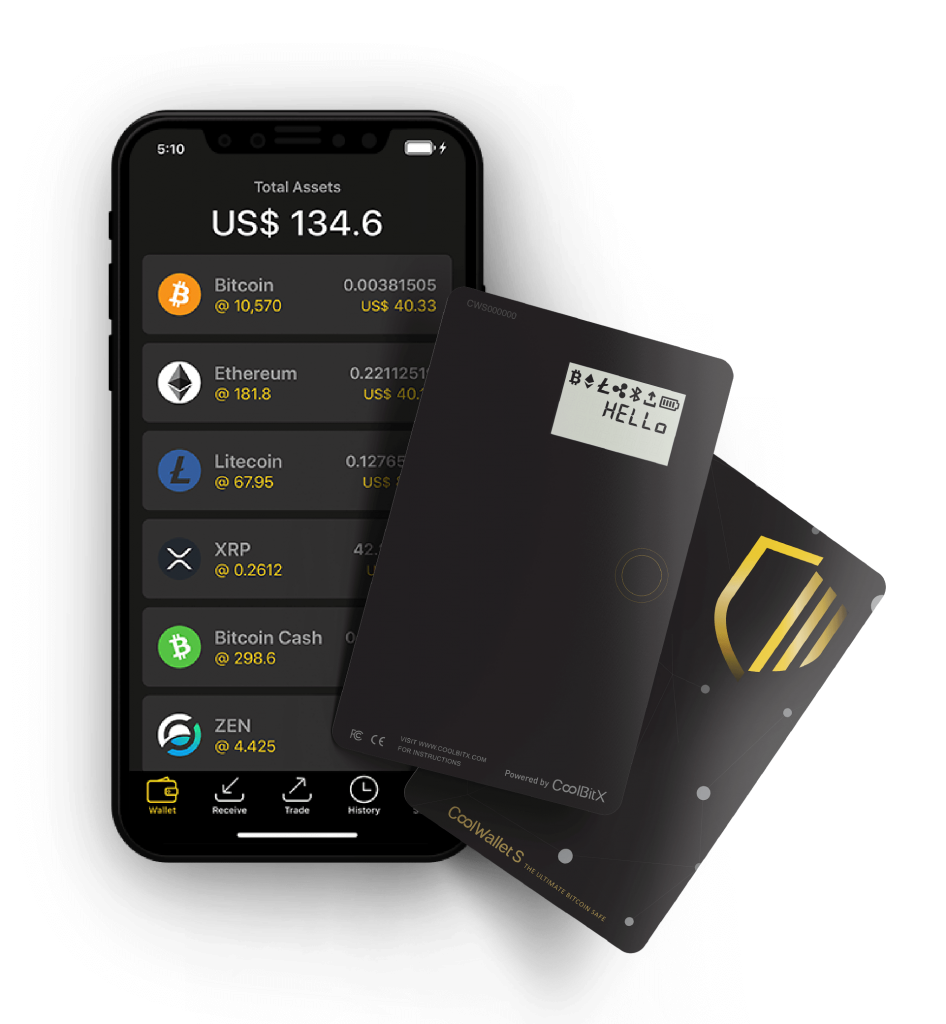
The CoolWallet S is a revolutionary hardware wallet first released in 2016. Its first-gen predecessor was the world’s first Bluetooth mobile hardware wallet. The CoolWallet S allows you to keep your crypto in cold storage, completely offline, in full control, and in your real-world wallet.
The CoolWallet’s EAL5+ secure element, encrypted military-grade Bluetooth protocol, and several biometric security checks ensure that you can take it with you everywhere you go, without the need to use custodial solutions like centralized exchanges.
Learn more: Here are 10 reasons why you should get a CoolWallet in 2021!
Disclaimer: CoolBitX provides these blog posts for general educational purposes only. Information on this blog expresses the opinion of the author only. It does not constitute professional legal or financial advice and should not be considered as such.
The author or company may update the information on this article at any time without prior notice and do not guarantee the work to be up to date and accurate. To the best of our knowledge, the information provided here is factual at the time of writing.

